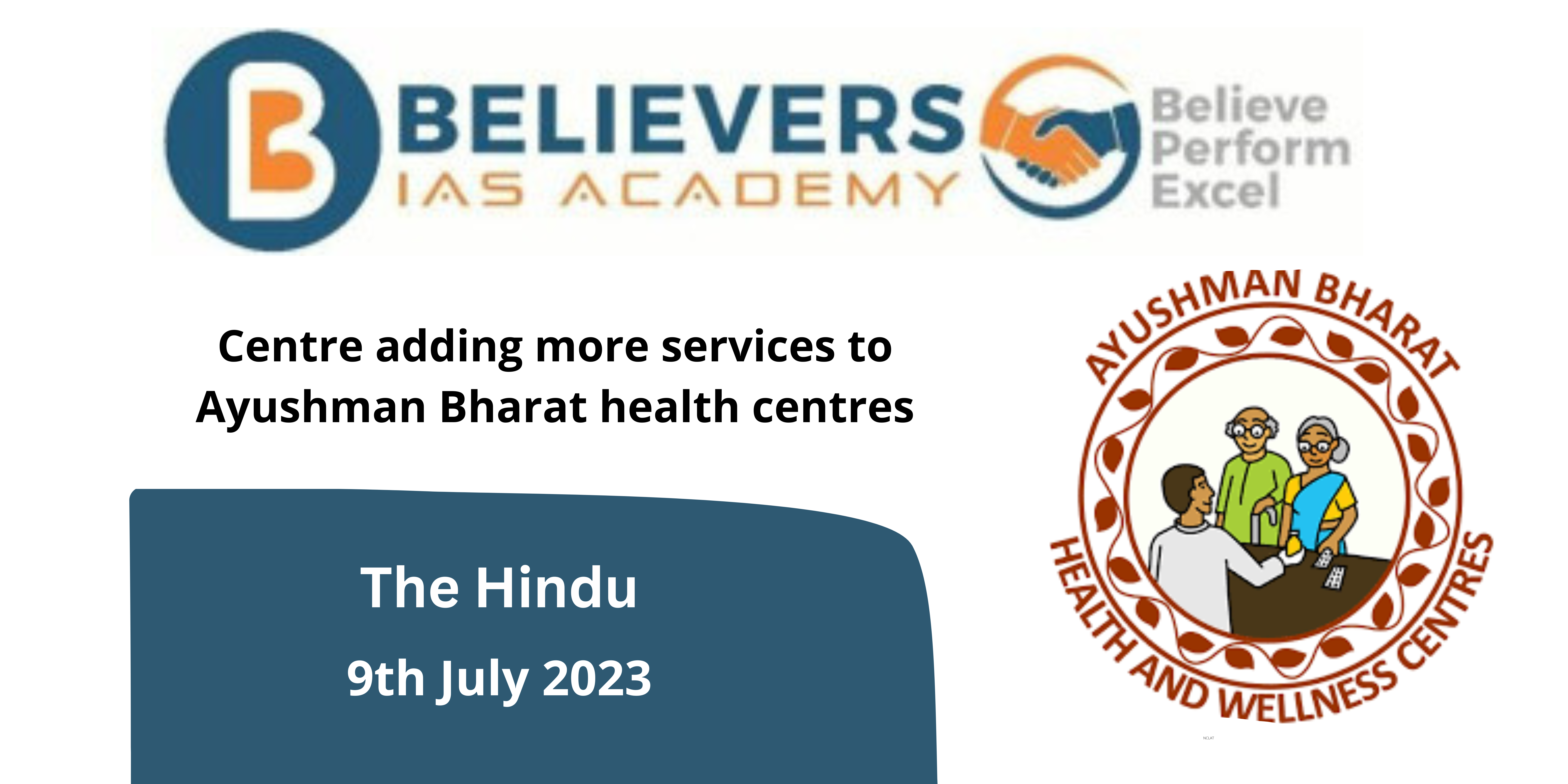Centre Adding More Services to Ayushman Bharat Health Centres
Context:
By the end of August, further services will be added to the current offerings, including screening, prevention, control, and management of non-communicable illnesses, treatment for common ophthalmology and ENT issues, senior and palliative health care services, and basic dental health care.
What are Ayushman Bharat Health Centers?
To move away from selective health care and towards a more complete spectrum of treatments covering preventative, promotive, curative, rehabilitative, and palliative care for all ages, the Ayushman Bharat – Health and Wellness Centres (AB-HWCs) were introduced under the Ayushman Bharat Programme. These facilities were envisioned as the cornerstone of India’s healthcare system in the National Health Policy of 2017.
What are the services provided under the Ayushman Bharat – Health and Wellness Centres (AB-HWCs)?
- Care for Pregnancy and Childbirth:
- Services for antenatal care that protect pregnant women’s health.
- Support and assistance during labour to encourage safe deliveries.
- Postnatal care to keep an eye on the mother’s and the child’s health.
- Services for neonatal and infant health care:
- Newborns and infants receive specialised treatment to ensure their wellbeing.
- Services for immunising against diseases that can be prevented.
- Screening for developmental delays or health problems and early identification.
- Childhood and Adolescent Health Care Services:
- Comprehensive healthcare for children and adolescents is provided by childhood and adolescent health care services.
- Monitoring of growth, vaccination, and dietary assistance.
- Early intervention and childhood illness screening.
- Services for family planning and reproductive health:
- Counselling on contraception and family planning techniques.
- Providing services and materials related to contraception.
- Prevention and treatment of problems with reproductive health.
- Treatment of Contagious Diseases:
- Governmental health programmes
- Implementation of national health initiatives for managing and controlling communicable illnesses.
- This includes initiatives to combat illnesses like leprosy and tuberculosis (TB).
- Management of common communicable diseases and general outpatient care:
- Treatment for common communicable diseases such as respiratory infections, diarrheal diseases, and skin infections.
- General outpatient treatment for minor disorders and acute, straightforward illnesses.
- Non-Communicable illnesses (NCDs) Screening, Prevention, Control, and Management:
- Risk factor screening and early detection of NCDs such as diabetes, hypertension, cardiovascular illnesses, etc.
- Encouraging the adoption of preventative measures and lifestyle changes.
- Offering management and treatment services for NCDs that have been identified.
- Basic Oral Health:
- Basic dental care treatments are offered as part of basic oral health care.
- Promotion and education of oral health.
- Referrals for cutting-edge dental care as needed.Common ophthalmic and ENT issues are treated with basic ENT (ear, nose, and throat) therapy.
What is the Ayushman Bharat programme mentioned here?
-
- To realise the goal of Universal Health Coverage (UHC), the Government of India’s flagship programme, Ayushman Bharat, was introduced as advised by the National Health Policy 2017. This programme was created to fulfil the Sustainable Development Goals (SDGs) and their core principle, “leave no one behind.“
- Ayushman Bharat represents an effort to transition from a sectoral and segmented approach to the delivery of health services to a comprehensive need-based strategy. This programme intends to implement ground-breaking interventions to holistically address the healthcare system at the primary, secondary, and tertiary levels (encompassing prevention, promotion, and ambulatory care). The continuum of care approach used by Ayushman Bharat consists of two interconnected parts:
-
-
-
-
- HWCs (Health and Wellness Centres)
- Pradhan Mantri Jan Arogya Yojana (PM-JAY)
-
-
-
What were the changes that the government is intending to make on these HWCs?
- Service Expansion:
- The AB-HWCs programme is currently experiencing its largest service expansion.
- Non-communicable disease screening, prevention, control, and management are among the new services being provided.
- Emergency medical services, basic dental health care, aged and palliative care, common ophthalmology and ENT disorders, and screening for and treatment of mental health conditions are also offered.
- By the end of August, it is intended to have reached every centre.
- Introduction of Health Officers:
- Community health officers are now available in secondary centres thanks to the introduction of a new cadre of these professionals.
- These officers—a total of 1.29 lakh—will run the public health department and serve as clinicians.
- They will be in charge of the group of auxiliary nurse midwives, Anganwadi workers, and accredited social health activists.
- National quality assurance standards:
- The National Quality Assurance Standards assessment and certification are advocated for AB-HWCs.
- By 2026, it is intended to have 50% of the centres certified.
- Comprehensive Primary Health Care (CPHC):
- The program’s goal is to offer comprehensive primary health care, which includes services for pregnant women and children, care for people with non-communicable diseases, and free access to basic medications and diagnostic tools.
- The intention is to increase the accessibility of these services and promote universal access to healthcare.
- Cumulative Screenings:
- The AB-HWCs initiative has carried out a sizable number of non-communicable illness screenings.
- The total number of screenings is more than 122.02 crore.
- This includes 36.16 billion screenings for diabetes, 24.75 billion for oral cancer, 11.44 billion for breast cancer, and 7.83 billion for cervical cancer.
These points emphasise the program’s broad range of screenings and wellness activities, the addition of community health officers, the emphasis placed on quality assurance, and the development of services.





